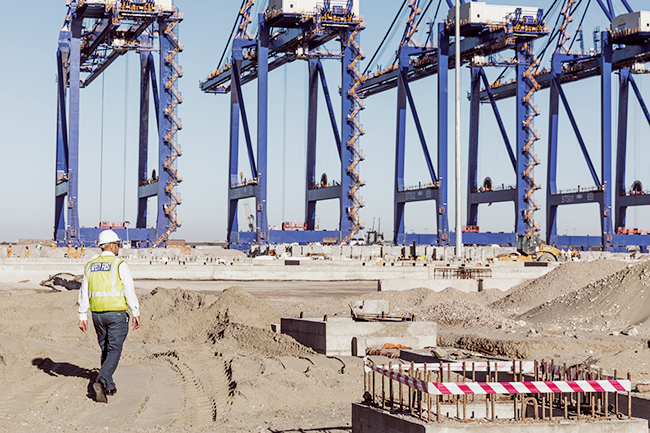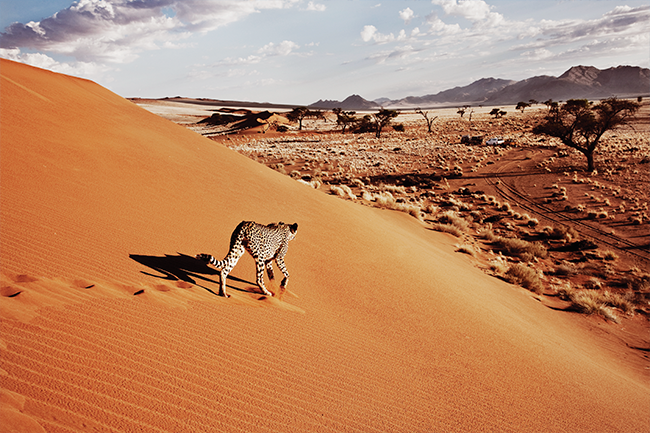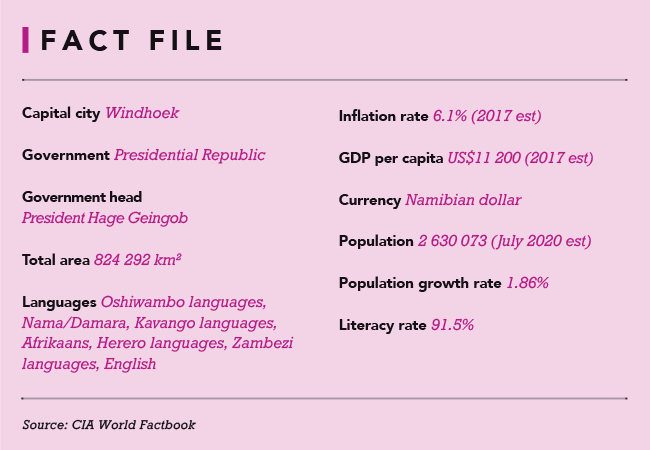Across the world economies are contracting in the wake of COVID-19. Hardest hit are the emerging and developing economies of Africa, more so those that have experienced a recession in recent years. Namibia is one of them.
In 2019, a state of emergency was declared due to the severity of an extreme drought and its impacts on the country’s agriculture. By no means was this the single cause of the entry into a recession, but it added further to the woes of an already declining mining sector – largely diamonds – as projects reached their end-of-life, and raw-material price drops affected construction. These circumstances were notably depressing because the country had, up to 2015, been experiencing robust growth and was set to address its macro-economic imbalances with stimulus packages.
Negative drops over the past five years, however, didn’t put the nation under too much stress; they were small in comparison to this year’s domestic contraction of 7.8%, as indicated by the Bank of Namibia. The almost-but-not-quite Black Swan pandemic has driven declines across a range of industries in the country, including hospitality, mining, storage transport, manufacturing, wholesale and retail trade, financial and insurance services, construction and agriculture.
Paulina Mbala Elago, executive secretary of Southern African Customs Union (SACU), notes that, with the onset of COVID-19, ‘global economic growth has been upended and facing greater headwinds comparable only to the Great Depression of the 1930s. Since June 2020, global economic growth recovery has been sluggish, which indicates that pre-pandemic growth levels will be hard to reach as economies rekindle production’.
Elago indicates that the subdued growth in South Africa – where growth is projected to contract sharply to -7.2% in 2020, due to the COVID-19 pandemic, credit downgrades and weak investor confidence – will have adverse implications for its neighbours, Botswana, Eswatini, Lesotho and Namibia, which are all SACU members.
She says that shares of SACU revenue are projected to decline in the coming year. Over the past five years, SACU revenue as a proportion of government expenditure in Namibia, has averaged about 33%. Growth in all the SACU countries is projected to contract in 2020, Botswana to -13.1%; Eswatini -6.2%; Lesotho -5.3%; and Namibia -6.6%.
‘Namibia’s average SACU receipt over the past three years, including what was predicted for 2021, is about 19% of the total SACU revenue. But with the regional decline of some 51% in receipts from April to July 2020 across the member states, that overall revenue will be lower than this trend,’ says Elago. ‘This comes at a time when there is a greater demand for more resources for the health sector in its fight against the spread of the pandemic. The financial constraint pressure means most of our member states may need to source external funding from institutions like the IMF and World Bank,’ she says, adding that Namibia will receive about ZAR22.3 billion for the 2020/21 financial year.
Growth is expected to be moderately buoyed by better prospects in the region beyond 2020 amid an improved global economic outlook. Consequently, Botswana is forecast to grow at 3.9%, Lesotho at 3.5%, Eswatini at 2.1%, Namibia at 1.1% and South Africa at 2.6% in 2021.
While all SACU member states are struggling with economies negatively affected by Covid-19, Elago highlights that during the hard lockdown, some countries were only able to process 10% to 30% of the normal cross-border trade volumes. This subsequently affected SACU revenue collection.
The advantage of an emerging economy such as Namibia is that while being among the hardest hit by factors beyond its control, it has the ability to respond quickly and recover similarly as fast.
The Namibian government is currently implementing a fiscal consolidation plan, including the limitation of public debt, which will create the space for public investment and private participation in infrastructure. This stimulates stronger public/private partnerships and allows the government to redistribute wealth without dire consequences for the business environment.
Reforms are being pushed to the top of the agenda, such as the removal of regulatory impediments to SMEs, the creation of an industrial development agency and an online business registration and licensing platform, addressing skills and expanding educational training.
A game-changer is the Walvis Bay Container Terminal, inaugurated last year, which has potential as a regional and logistics hub for the SADC region. Built on entirely reclaimed land through the creation of an artificial platform, this port expansion has increased throughput capacity from 355 000 to 750 000 TEU. It also has the added benefit of being able to boost tourism with the addition of a passenger liner berth and small craft harbour which is intended ultimately to support a commercial waterfront development.
The Walvis Bay Corridor Group, created in 2000, is capable of turning the country into the leading trade route in Southern Africa. Within this structure are the Trans-Kalahari Corridor (a paved highway linking Walvis Bay and the capital Windhoek to Botswana and South Africa); the Trans-Caprivi Corridor (which provides access to the ocean for the DRC, Zambia and Zimbabwe through southern Angola); and the Cunene Corridor, from Walvis Bay to as far as Lubango in Angola. And then there’s the Trans-Oranje Corridor, which links the port of Lüderitz with South Africa’s Northern Cape.
In addition, the group is also exploring the feasibility of a SADC high-speed railway line intended to connect Walvis with Windhoek, Gaborone in Botswana and Pretoria in South Africa, which will further unlock the economic potential of Namibia’s logistics, and stimulate industrial value chains.
It’s a similar story with the tourism sector. Namibia’s tourism contributed 14.7% to GDP in 2019 and was on a growth path albeit sluggish pre-March 2020; with increases of 2.5% for total arrivals and 1.3% for foreign arrivals. The country is a popular destination for nearby citizens of Angola, South Africa, Zambia, Zimbabwe and Botswana; and further afield from Germany, France, the UK, the US and China. But it all came crashing down with COVID-19 lockdowns and border closures.
Norbert Wurm is the MD of O&L Leisure – a subsidiary of the Ohlthaver & List (O&L) Group (Namibia’s largest private group of companies), which incidentally is not only concerned with leisure but also owns breweries, fisheries, dairies, and has operations in IT, retail and meat.
O&L is, Wurm says, the biggest private-sector employer in Namibia, which qualifies him to comment on the state of the overall economy, more specifically leisure, which he describes as ‘on its knees’, which is devastating to the country.
‘Tourism has always been the biggest export product for Namibia. It creates up to 30 000 direct and 120 000 indirect jobs. However, unknowns prevail at this point and with much of the leisure-industry facilities converted to quarantine enclaves, it’s difficult to say whether the 5% to 10% occupancy we currently register is distorted.’

Namibia attracts more than 1 million visitors annually. It’s one of the five signatories of the Kavango-Zambezi Transfrontier Conservation Area, a region where the borders of Zambia, Namibia, Zimbabwe, Botswana and Angola meet.
It taps into the travel agendas of those visiting Chobe, Vic Falls and the Kgalagadi and Caprivi transfrontier parks, and those who want to travel further to visit the 81 000 km2 Namib desert and the Skeleton Coast, both of which offer a sense of the raw but beautiful isolation of the region.
They are also attracted to the first German enclave in the region, Lüderitz, and the sand-absorbed ghost town Kolmanskop. Namibia is host to the world’s largest population of free-roaming cheetahs; one of only two countries that has desert elephants, and home to the world’s largest population of the threatened black rhino. It is also, according to the UN, the first country globally to incorporate environmental protection into its constitution.
‘In being one of the world’s most sparsely populated areas, social distancing comes naturally in Namibia,’ says Wurm. ‘It’s the ideal post-COVID travel destination. As we adapt to tourism revival initiatives and with the high season upon us, we need to encourage international support,’ he says.
‘Bilateral agreements are going to be critical for the leisure industry’s survival, especially for middle to high-end markets. In the long run though there is anticipation that there will be continued investment in the sector, and that sets us up for exciting times ahead.’
By Kerry Dimmer
Images: Gallo/Getty Images, Flickr/AfDB Projects




